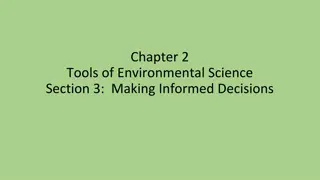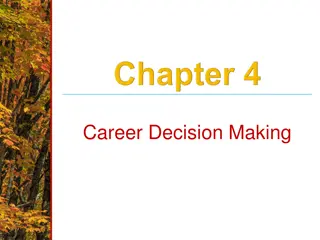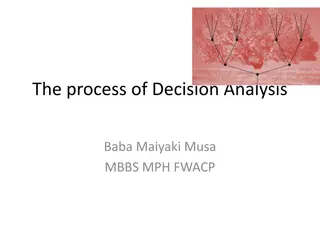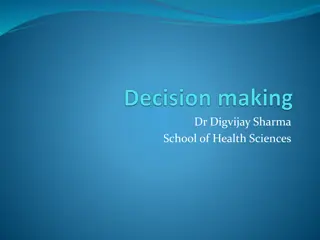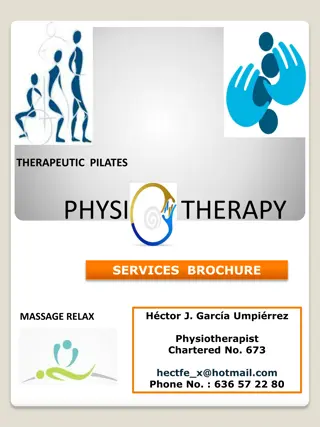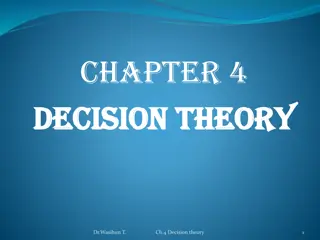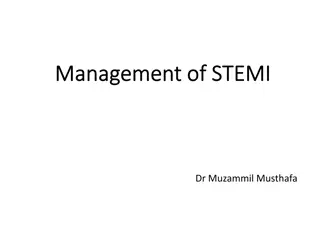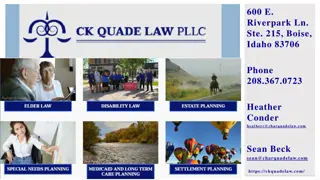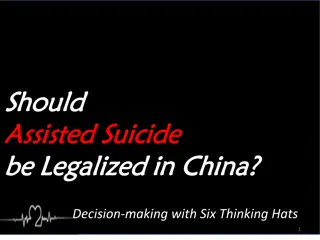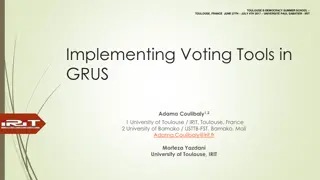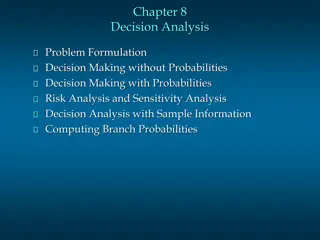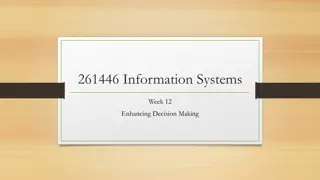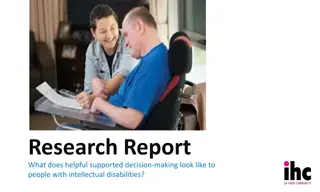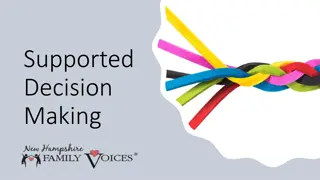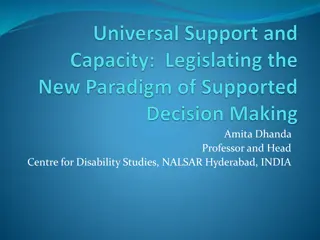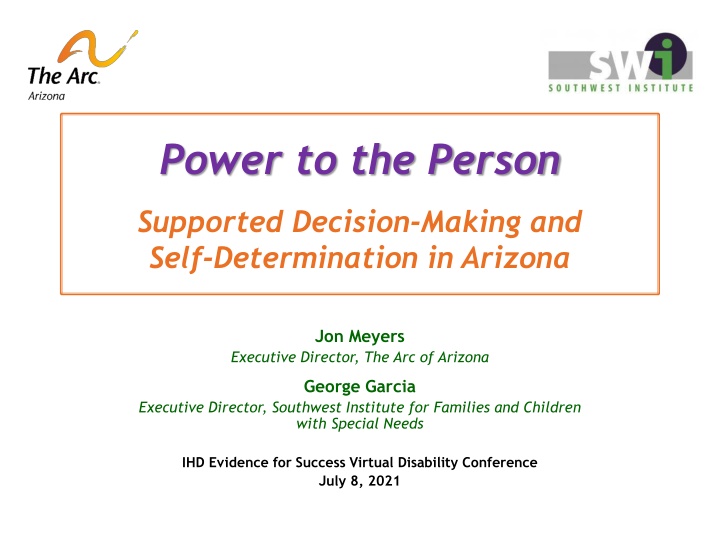
Empowering Decision-Making: Supported Self-Determination in Arizona
Discover the concept of Supported Decision-Making (SDM) and its importance in promoting autonomy and self-determination for individuals with disabilities. Learn about various decision-making supports, the pillars of SDM, and the rights of individuals to self-determination.
Download Presentation

Please find below an Image/Link to download the presentation.
The content on the website is provided AS IS for your information and personal use only. It may not be sold, licensed, or shared on other websites without obtaining consent from the author. If you encounter any issues during the download, it is possible that the publisher has removed the file from their server.
You are allowed to download the files provided on this website for personal or commercial use, subject to the condition that they are used lawfully. All files are the property of their respective owners.
The content on the website is provided AS IS for your information and personal use only. It may not be sold, licensed, or shared on other websites without obtaining consent from the author.
E N D
Presentation Transcript
Power to the Person Supported Decision-Making and Self-Determination in Arizona Jon Meyers Executive Director, The Arc of Arizona George Garcia Executive Director, Southwest Institute for Families and Children with Special Needs IHD Evidence for Success Virtual Disability Conference July 8, 2021
What are Decision-Making Supports? Formal and informal ways people can have others help them make decisions: Advice and Guidance Representative Payee Powers of Attorney for Financial Matters and Health Care Matters Supported Decision-Making
We Use Decision-Making Supports Every Day Think about common choices you make: Changing jobs Moving What to have for dinner and the list goes on
What is Supported Decision-Making? Supported Decision-Making (SDM) can be used by anyone, including people with I/DD, people with mental health issues, seniors SDM can be informal or formal Person using SDM chooses a team of people to help him/her make decisions Supporters agree to be available for advice and assistance Supporters do not make decisions for person using SDM, except in specific circumstances
What is Supported Decision-Making? Increasingly, around the world, there is legal recognition of SDM agreements Texas was first US state to pass a law recognizing SDM agreements 10 states plus DC currently recognize, with several more pending
Three Pillars of SDM Self-Determination Presumed Competence Dignity of Risk
Self-Determination People with intellectual and/or developmental disabilities (I/DD) have the same right to, and responsibilities that accompany, self-determination as everyone else. They must have opportunities, respectful support, and the authority to exert control in their lives, to self-direct their services to the extent they choose, and to advocate on their own behalf. Including: The right to take risks The right to choose their own allies The right to lead in decision-making about all aspects of their lives (excerpts from The Arc s Position Statement on Self-Determination)
Dignity of Risk The concept that acknowledges risk is a natural part of life that helps all people learn and develop The freedom to make mistakes, to make decisions for ourselves, even if others believe that that choices could be in error.
Right to Risk Security is mostly a superstition. It does not exist in nature, nor do the children of men as a whole experience it. Avoiding danger is no safer in the long run than outright exposure. Life is either a daring adventure or it is nothing. - Helen Keller
Why Supported Decision-Making Matters Moving away from paternalistic and medical model of disability Empowerment vs. Substitution Natural way to grow a circle of support
Differentiating SDM from PCP Supported Decision- Making Person-Centered Planning Focuses on setting goals Affects interactions with agencies Covers activities within agencies purview Focuses on creating a process Affects interactions with the world Covers the universe of decisions
Basic Components Gathering necessary information Educating individual about that information Identifying possibilities and alternatives Aiding individual in weighing choices and understanding consequences Helping communicate decisions to others Assisting in implementation of decisions
SDM Alternatives to Guardianship Third-party financial management Specified case management/support coordination Advance directives Limited or standby guardianship when properly applied
Conflicts of Interest Retaining capacity provides protections from many forms of abuse or exploitation Power dynamic shifts Conflict of interest provisions should restrict who may serve as supporter: Doctors Those with major financial interest Provider staff
Where It Works Outside U.S., notable nations with Co- Decision Making acts include: Australia Canada Ireland Israel Sweden United Kingdom
Where It Works Effective SDM Laws: Recognize right of person with disability to: Voluntarily enter into SDM agreement with supporter(s) Determine scope of agreement Terminate agreement Specify protections against abuse, neglect, exploitation Provide templates of required content Mandate reporting
What Systems Change is Needed to Make Supported Decision-Making a Reality? Work together to gain recognition of SDM: Public Financial & Educational Institutions Health Care System Judicial System Build Decision-Making Skills For adults For children
Barriers to Acceptance Limited experience Few examples from which to learn Brief history of U.S. laws Lack of conceptual understanding Policymakers Support providers Individuals & family members Concerns about coercion & abuse History of third-party authority
Barriers to Acceptance Individual & institutional attitudes Fear Uncertainty of political climate Equity Individualized approach Not cookie-cutter solution Investment of time, expertise, money Funding Institutional inertia: Power of the Status Quo
Overcoming Barriers Overcoming barriers to Supported Decision-Making requires more than simply changing Guardianship laws.
Overcoming Barriers Education & Advocacy Individuals with disabilities Communities Grassroots families & support networks Advocacy & service organizations Legal professionals Healthcare providers Financial institutions Education entities
Overcoming Barriers Education & Advocacy Housing providers I/DD Service Providers State & Federal Governments Agency leadership Legislators Courts
Overcoming Barriers Systems Change Focus on individual rather than preservation of system SDM options first consideration; full guardianship a last resort Safeguards built into SDM structure Understanding & acceptance of risk Trial & error Ongoing training, revision, reinforcement Collective action It Takes a Village
Supported Decision-Making Pilot Project
Arizonas Developmental Disabilities Planning Council Each state and territory of the United States has a council on developmental disabilities focused on advocacy, inclusion and improving access and services, as outlined in the Developmental Disabilities Assistance and Bill of Rights Act of 2000.
Grant Partners Southwest Institute for Families and Children supports people with disabilities through empowerment, advocacy, and knowledge. ACDL is a non-profit law firm that assists Arizonans with disabilities to promote and protect their legal rights to independence, justice, and equality. The Arc of Arizona advocates for the rights and full community participation of all people with intellectual and developmental disabilities by improving systems of supports and services, connecting families, inspiring communication, and influencing public policy.
Project Goal Increase the use of Supported Decision- Making among individuals with intellectual and developmental disabilities as an alternative to legal guardianship.
Understanding the Landscape Forums conducted in northern, central, and southern Arizona Parents and caregivers Young adults with I/DD Interviews with relevant stakeholders Medical providers Education professionals legal professionals Social service providers
White Paper: Our Findings Widespread misunderstanding about legal guardianship necessity, process, responsibilities, implications, limitations Misinformation is rampant Spread by institutional as well as informal sources Rural areas, in particular, have few reliable resources Continues to be seen as default option
Our Findings (cont.) Very little familiarity with concept of Supported Decision-Making Families/caregivers Individuals with I/DD Professionals Resistance likely from some stakeholder communities But, eagerness to learn more
How We Will Reach Our Goal Teach family members and caregivers, individuals with I/DD, and all relevant stakeholders about Supported Decision-Making. Pass legislation recognizing Supported Decision- Making as a less restrictive alternative to legal guardianship. Continually advocate for acceptance of SDM in concept and in practice
People with I/DD, families, and caregivers Learn the differences between Supported Decision- Making and legal guardianship Learn how to identify and select trustworthy supporters Learn how to create a supported decision-making agreement
Legal & Judicial Community Learn about intellectual and developmental disabilities Learn the differences between Supported Decision-Making and legal guardianship Learn the proper role and responsibilities of trusted advisors within a Supported Decision- Making relationship
Social Service Providers, Medical and Education professionals Learn about Supported Decision-Making and its benefits Learn how to develop a Supported Decision-Making relationship with a client or patient Learn how to best work with a client or patient who uses Supported Decision-Making
Legislation Collaborated with disability partners to develop legislation Introduced in the AZ legislative session Educated lawmakers and state agency leaders Encouraged advocacy for proposed legislation among various stakeholder communities
Creating A Supported Decision- Making Reality in Arizona - Together House Bill 2538 (2021) Rep. Jennifer Longdon (D-24) Prime sponsor Co-sponsors: Reps. Tim Dunn (R-13), Becky Nutt (R-14), Diego Rodriguez (D-27), Athena Salman (D-26), Judy Schwiebert (D-10), Lorenzo Sierra (D-19) Passed House of Representatives 59-0; failed in Senate 15-14 Will be re-introduced in 2022 session
Resources Southwest Institute for Families & Children http://swifamilies.org/supported-decision-making-pilot- project/ National Resource Center for Supported Decision-Making http://supporteddecisionmaking.org/ Center for Public Representation https://supporteddecisions.org/ The Arc Wisconsin Learn about Supported Decision-Making in Wisconsin https://arcwi.org/2018/04/13/supported-decision-making/ The Arc s Center for Future Planning https://futureplanning.thearc.org/
Questions? Jon Meyers (602) 290-1632 / jon@arcarizona.org George Garcia (602) 235-0354 x801 / g.garcia@swifamilies.org


